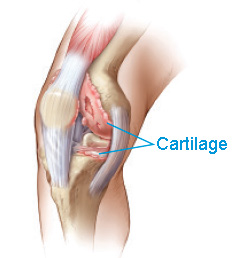
The knee is like a hinge that joins your thigh bone (femur) to your shin bone (tibia). Cartilage provides a cushion between the bones. Muscles and tendons connect them and keep the joint stable. When healthy, these parts work together to let you bend your knee smoothly and without pain.
If your knees ache, they have lots of company. Over 46 million Americans suffer from arthritis.1 Osteoarthritis is the most common type, and the way it works in the knee is pretty simple. Three bones meet up at the knee joint: the end of the thigh bone (femur), the top of the shin bone (tibia), and the kneecap (patella). Those bones are cushioned by cartilage, but when the cartilage is injured or worn away—which is actually the definition of osteoarthritis—the bones grind against each other. That grinding hurts. You can feel it climbing stairs, working in the garden, or just bending your knees to sit. It may even keep you up at night.
Why you?
Researchers are finding a strong link between genetics and osteoarthritis. In other words, if your mother had it, you’re more prone to have it too.2 Other contributing factors may be trauma to the knee, overuse on the job (think of those major league baseball catchers), or being overweight. In addition, osteoarthritis can occur when joints are out of alignment, as in people who are bowlegged or knock-kneed.
Diagnosis

In an osteoarthritic knee, the cartilage has thinned and deteriorated, allowing bone to rub against bone and cause pain.
Early diagnosis of arthritis and tailored treatment are crucial in slowing or preventing damage to your joints. Only a physician can determine if you have arthritis, based on:
- the overall pattern of symptoms
- medical history
- physical exam
- X-rays and other imaging techniques
- lab tests
The good news about arthritis in the knee is that it can be treated. Here are some signs that it might be time to talk to your doctor:
- Pain persists or recurs over time
- Pain worsens after exercise or other weight-bearing activities
- Pain in rainy weather
- Pain prevents you from sleeping
- A decrease in knee motion or the degree to which you’re able to bend your knee
- Stiff or swollen knees
- Difficulty walking or climbing stairs
- Difficulty getting in and out of chairs and bathtubs
- Morning stiffness that typically lasts less than 30 minutes (as opposed to stiffness lasting longer than 45 minutes, a sign of an inflammatory condition called rheumatoid arthritis)
- “Grating” of the joint
- Previous injury to the anterior cruciate ligament (ACL) of the knee
